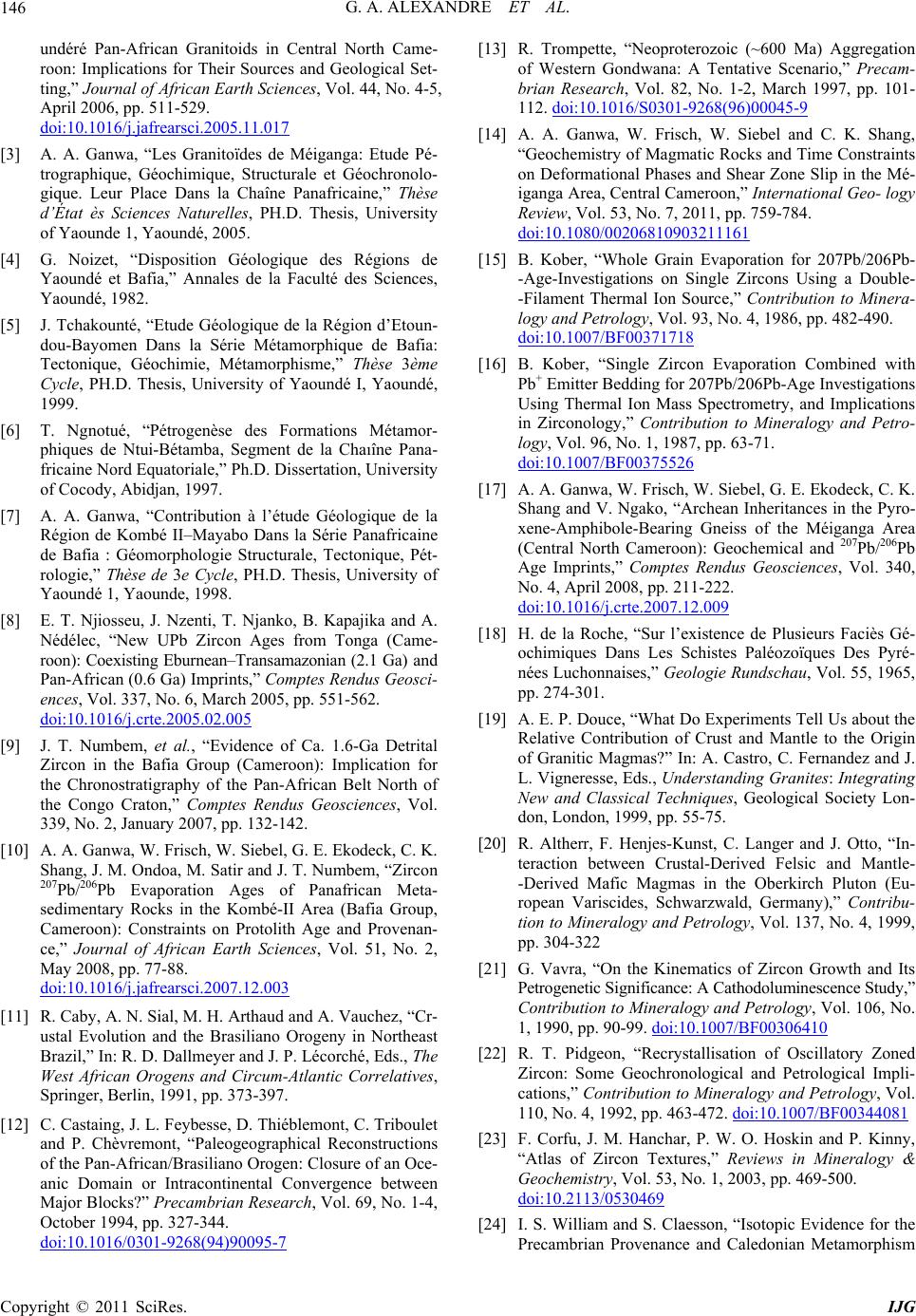
G. A. ALEXANDRE ET AL.
146
undéré Pan-African Granitoids in Central North Came-
roon: Implications for Their Sources and Geological Set-
ting,” Journal of African Earth Sciences, Vol. 44, No. 4-5,
April 2006, pp. 511-529.
doi:10.1016/j.jafrearsci.2005.11.017
[3] A. A. Ganwa, “Les Granitoïdes de Méiganga: Etude Pé-
trographique, Géochimique, Structurale et Géochronolo-
gique. Leur Place Dans la Chaîne Panafricaine,” Thèse
d’État ès Sciences Naturelles, PH.D. Thesis, University
of Yaounde 1, Yaoundé, 2005.
[4] G. Noizet, “Disposition Géologique des Régions de
Yaoundé et Bafia,” Annales de la Faculté des Sciences,
Yaoundé, 1982.
[5] J. Tchakounté, “Etude Géologique de la Région d’Etoun-
dou-Bayomen Dans la Série Métamorphique de Bafia:
Tectonique, Géochimie, Métamorphisme,” Thèse 3ème
Cycle, PH.D. Thesis, University of Yaoundé I, Yaoundé,
1999.
[6] T. Ngnotué, “Pétrogenèse des Formations Métamor-
phiques de Ntui-Bétamba, Segment de la Chaıîne Pana-
fricaine Nord Equatoriale,” Ph.D. Dissertation, University
of Cocody, Abidjan, 1997.
[7] A. A. Ganwa, “Contribution à l’étude Géologique de la
Région de Kombé II–Mayabo Dans la Série Panafricaine
de Bafia : Géomorphologie Structurale, Tectonique, Pét-
rologie,” Thèse de 3e Cycle, PH.D. Thesis, University of
Yaoundé 1, Yaounde, 1998.
[8] E. T. Njiosseu, J. Nzenti, T. Njanko, B. Kapajika and A.
Nédélec, “New UPb Zircon Ages from Tonga (Came-
roon): Coexisting Eburnean–Transamazonian (2.1 Ga) and
Pan-African (0.6 Ga) Imprints,” Comptes Rendus Geosci-
ences, Vol. 337, No. 6, March 2005, pp. 551-562.
doi:10.1016/j.crte.2005.02.005
[9] J. T. Numbem, et al., “Evidence of Ca. 1.6-Ga Detrital
Zircon in the Bafia Group (Cameroon): Implication for
the Chronostratigraphy of the Pan-African Belt North of
the Congo Craton,” Comptes Rendus Geosciences, Vol.
339, No. 2, January 2007, pp. 132-142.
[10] A. A. Ganwa, W. Frisch, W. Siebel, G. E. Ekodeck, C. K.
Shang, J. M. Ondoa, M. Satir and J. T. Numbem, “Zircon
207Pb/206Pb Evaporation Ages of Panafrican Meta-
sedimentary Rocks in the Kombé-II Area (Bafia Group,
Cameroon): Constraints on Protolith Age and Provenan-
ce,” Journal of African Earth Sciences, Vol. 51, No. 2,
May 2008, pp. 77-88.
doi:10.1016/j.jafrearsci.2007.12.003
[11] R. Caby, A. N. Sial, M. H. Arthaud and A. Vauchez, “Cr-
ustal Evolution and the Brasiliano Orogeny in Northeast
Brazil,” In: R. D. Dallmeyer and J. P. Lécorché, Eds., The
West African Orogens and Circum-Atlantic Correlatives,
Springer, Berlin, 1991, pp. 373-397.
[12] C. Castaing, J. L. Feybesse, D. Thiéblemont, C. Triboulet
and P. Chèvremont, “Paleogeographical Reconstructions
of the Pan-African/Brasiliano Orogen: Closure of an Oce-
anic Domain or Intracontinental Convergence between
Major Blocks?” Precambrian Research, Vol. 69, No. 1-4,
October 1994, pp. 327-344.
doi:10.1016/0301-9268(94)90095-7
[13] R. Trompette, “Neoproterozoic (~600 Ma) Aggregation
of Western Gondwana: A Tentative Scenario,” Precam-
brian Research, Vol. 82, No. 1-2, March 1997, pp. 101-
112. doi:10.1016/S0301-9268(96)00045-9
[14] A. A. Ganwa, W. Frisch, W. Siebel and C. K. Shang,
“Geochemistry of Magmatic Rocks and Time Constraints
on Deformational Phases and Shear Zone Slip in the Mé-
iganga Area, Central Cameroon,” International Geo- logy
Review, Vol. 53, No. 7, 2011, pp. 759-784.
doi:10.1080/00206810903211161
[15] B. Kober, “Whole Grain Evaporation for 207Pb/206Pb-
-Age-Investigations on Single Zircons Using a Double-
-Filament Thermal Ion Source,” Contribution to Minera-
logy and Petrology, Vol. 93, No. 4, 1986, pp. 482-490.
doi:10.1007/BF00371718
[16] B. Kober, “Single Zircon Evaporation Combined with
Pb+ Emitter Bedding for 207Pb/206Pb-Age Investigations
Using Thermal Ion Mass Spectrometry, and Implications
in Zirconology,” Contribution to Mineralogy and Petro-
logy, Vol. 96, No. 1, 1987, pp. 63-71.
doi:10.1007/BF00375526
[17] A. A. Ganwa, W. Frisch, W. Siebel, G. E. Ekodeck, C. K.
Shang and V. Ngako, “Archean Inheritances in the Pyro-
xene-Amphibole-Bearing Gneiss of the Méiganga Area
(Central North Cameroon): Geochemical and 207Pb/206Pb
Age Imprints,” Comptes Rendus Geosciences, Vol. 340,
No. 4, April 2008, pp. 211-222.
doi:10.1016/j.crte.2007.12.009
[18] H. de la Roche, “Sur l’existence de Plusieurs Faciès Gé-
ochimiques Dans Les Schistes Paléozoïques Des Pyré-
nées Luchonnaises,” Geologie Rundschau, Vol. 55, 1965,
pp. 274-301.
[19] A. E. P. Douce, “What Do Experiments Tell Us about the
Relative Contribution of Crust and Mantle to the Origin
of Granitic Magmas?” In: A. Castro, C. Fernandez and J.
L. Vigneresse, Eds., Understanding Granites: Integrating
New and Classical Techniques, Geological Society Lon-
don, London, 1999, pp. 55-75.
[20] R. Altherr, F. Henjes-Kunst, C. Langer and J. Otto, “In-
teraction between Crustal-Derived Felsic and Mantle-
-Derived Mafic Magmas in the Oberkirch Pluton (Eu-
ropean Variscides, Schwarzwald, Germany),” Contribu-
tion to Mineralogy and Petrology, Vol. 137, No. 4, 1999,
pp. 304-322
[21] G. Vavra, “On the Kinematics of Zircon Growth and Its
Petrogenetic Significance: A Cathodoluminescence Study,”
Contribution to Mineralogy and Petrology, Vol. 106, No.
1, 1990, pp. 90-99. doi:10.1007/BF00306410
[22] R. T. Pidgeon, “Recrystallisation of Oscillatory Zoned
Zircon: Some Geochronological and Petrological Impli-
cations,” Contribution to Mineralogy and Petrology, Vol.
110, No. 4, 1992, pp. 463-472. doi:10.1007/BF00344081
[23] F. Corfu, J. M. Hanchar, P. W. O. Hoskin and P. Kinny,
“Atlas of Zircon Textures,” Reviews in Mineralogy &
Geochemistry, Vol. 53, No. 1, 2003, pp. 469-500.
doi:10.2113/0530469
[24] I. S. William and S. Claesson, “Isotopic Evidence for the
Precambrian Provenance and Caledonian Metamorphism
Copyright © 2011 SciRes. IJG